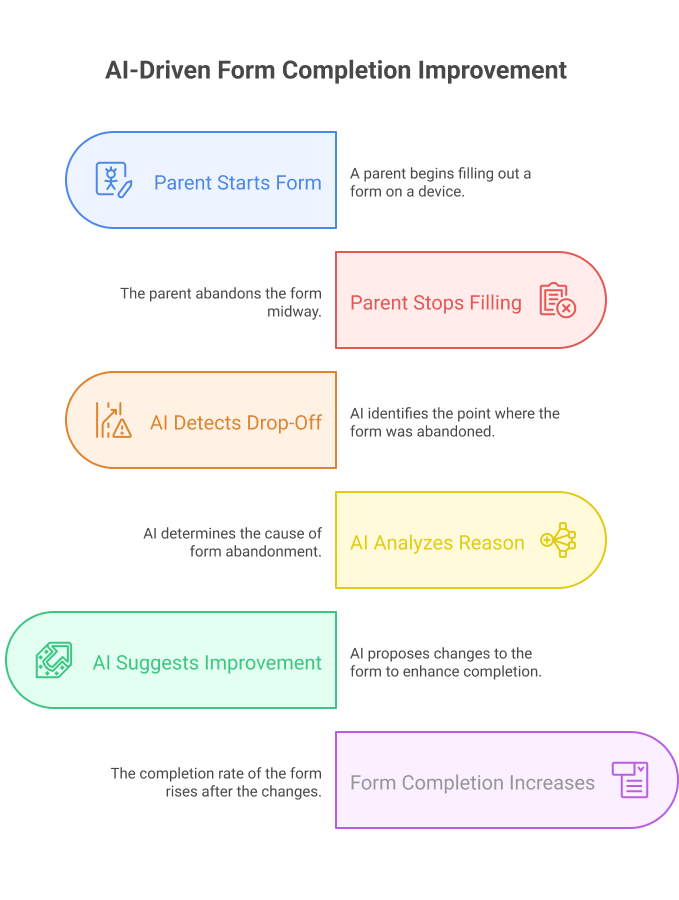AI is making its way into early education in many helpful ways. It’s already helping teachers plan lessons, write reports, and save time on daily tasks.
But there’s another place where AI can make a real difference: helping more families complete the enrollment process.
A lot of preschools run into the same problem – parents show interest, maybe even take a tour… and then nothing. No follow-up. No enrollment. Just silence.
These moments are called enrollment dropoffs, and they’re more common than you might think.
With the right tools, AI can help you spot these dropoffs early and gently guide families back on track.
What Are Enrollment Dropoffs, And Why Do They Matter?
An enrollment dropoff happens when a parent starts the enrollment journey but doesn’t finish it.
They might fill out an inquiry form and then stop responding.
They might come for a tour but never follow up.
Some even ask for fee details and go quiet before registration.
These dropoffs can happen at any stage, and they add up quickly.
Why do parents drop off during enrollment?
- They don’t get the right follow-up in time. Research[1] shows that consistent and personalized follow-ups are crucial in guiding families through the enrollment funnel.
- The process feels slow or confusing.
- They’re still unsure about your center.
Why does it matter?
- Fewer enrollments mean lost revenue.
- Your staff spends time on leads that don’t convert.
- It’s harder to plan programs when you don’t know how many will join.
This is where AI comes in.
AI can help you spot when a lead is going cold, figure out why it’s happening, and help you reach out in a smarter way.
Let’s look at how AI provides support at different stages of the enrollment funnel, and how it can help keep families moving forward.
%201.png)
How AI Helps During the Lead Capture Stage
The enrollment journey usually begins with a parent showing interest. Maybe they visit your website, see an ad, or hear about your center from a friend. At this stage, your goal is simple: capture that interest before it fades.
AI can play a big role in helping you do that better.
Catching Lost Leads Before They Slip Away

When a parent starts filling out an inquiry form but doesn’t hit submit, that’s a lead at risk. Most systems can flag an incomplete form, but AI takes it further.
AI tools can detect exact drop-off points, like which questions cause parents to pause or exit. It can also track patterns across many submissions to show what’s working and what’s not.
Let’s say 40% of parents drop off after reaching a section about work details. That insight helps you spot friction, simplify those fields, or reword them. Over time, this reduces dropoffs and improves form completion rates.
AI can also trigger a timely reminder email based on how far the parent got in the form and how long ago they dropped off, all without manual effort.
Following the best practices for online enrollment forms is important, and knowing exactly where families drop off and why helps you improve faster. That’s the difference AI can make.
Spend Less on Unresponsive Leads, More on What Works
You’re likely getting inquiries from many places, like your website, Facebook, Instagram, word of mouth, walk-ins, and more. But not all leads are the same.
Some sources bring families who convert quickly, others just bring clicks and not enrollments.
AI helps you see what’s really happening behind the numbers. It can:
- Compare lead sources by conversion rate, not just volume
- Show how long each source takes to move from inquiry to enrollment
- Highlight which sources consistently bring dropoffs
Talk to the Right Parents at the Right Time
Some parents are in a hurry to start next week, while others are planning for next term. But when your inbox is full of inquiries, it’s hard to know who needs urgent attention and who’s just exploring.
AI can automatically sort and group leads by their preferred start date. It shows you which parents are ready to enroll now and who might need follow-ups later. Your team can focus on families who are ready to enroll, while AI keeps others engaged with automated emails like program brochures or open house invites.
When you talk to the right parents at the right time, your chances of enrollment go way up, and AI helps you do that without the guesswork.
How AI Helps During the Lead Nurturing and Engagement Stage
%201.png)
Once a parent shows interest, the next step is keeping that interest alive. This is where most dropoffs happen, especially if follow-ups are slow, not personalized, or just not enough.
AI can help you engage smarter.
Personalize Follow-Ups Without the Extra Work
Every family is different, but when leads pile up, it’s easy to treat them all the same.
AI helps by grouping inquiries based on key details like the child’s age, gender, preferred start month, and location. These smart groupings let your team send updates and follow-ups that actually make sense for each family.
Know When to Follow Up and When to Pause
Every parent responds differently. Some need just one call before they book a tour. Others need a few reminders before they take the next step. The challenge is knowing when to follow up, and when to give space.
AI can look at your past enrollment data and show you what actually works. It learns how many follow-ups different parent groups usually need based on factors like child’s age, inquiry source, and timeline.
Reach Parents on the Channel They Actually Use
Not all parents prefer the same mode of communication. Some check their WhatsApp every hour. Others might only respond to emails in the evening or answer calls during lunch breaks.
AI can analyze your past engagement data and show you which channels work best for different types of families based on factors like inquiry source, age group, or region.
With that insight, you start tailoring your outreach. You message each parent on the channel they actually use. As a result, you get more replies, better conversations, and fewer missed follow-ups.
When parents hear from you in the way that feels most natural to them, they’re more likely to stay in touch and complete enrollment.
Say the Right Thing in the Right Way
A good message gets a reply. A great one builds trust.
AI tools can help you craft smarter, more effective messages by learning what’s worked in the past. It can suggest subject lines, body copy, and even the best time to send. All based on real parent response data.
Know Which Parents Are Most Likely to Enroll
With dozens of inquiries coming in, it’s hard to know who’s ready to enroll and who’s just browsing. This is where AI-powered lead confidence scores can make a big difference.
AI looks at multiple signals to give each lead a score, helping your team focus on families who are most likely to convert. Here's how it works:
- Recency of interaction: The more recently a parent replied to a message or filled a form, the higher their interest. If it’s been two weeks since their last interaction, they may need a gentle nudge.
- Tour status: Families who have already booked or attended a tour are far more likely to enroll. If they haven’t booked one yet, they might still be on the fence.
- Form and document submissions: If they’ve shared required documents or filled in parts of the registration form, they’re clearly interested. That bumps their score up.
- Source and interaction type: Leads from referrals often score higher than cold social media clicks. Similarly, those who’ve requested a quote or received an invoice are further along in the process.
Create Video Tours Without a Production Team
Many parents want a quick look at your center before they commit to a visit. But not every preschool has the time or team to shoot polished videos.
AI-powered tools make it easier to turn basic phone footage into engaging video tours. You can upload clips of your classrooms, staff, or daily activities, and AI can:
- Cut out long pauses or shaky sections
- Add soft music or captions
- Organize clips into a smooth, easy-to-watch format
How AI Helps During the Conversion Stage
This is the final step. The parent has shown strong interest. They’ve likely toured your center, asked questions, and are thinking about enrolling. But even now, dropoffs are possible.
A missed follow-up, a confusing form, or a delay in sending details can cause families to walk away.
AI helps you close the loop with care and consistency.
Keep Every Family in the Loop, Without Misses
AI helps by keeping all communication timely and complete. Whether it’s sending the enrollment form, sharing fee breakdowns, or answering last-minute questions, nothing falls through the cracks. Parents get the right information at the right time, and your center looks responsive and organized.
Automatically Guide Parents Through the Final Steps
Once a parent is ready to enroll, your job is to make the next steps feel simple and clear. But if the process feels confusing or delayed, even warm leads can drop off.
AI can trigger a step-by-step enrollment flow as soon as a parent shows intent. It can:
- Send the correct registration forms
- Request documents based on age or program
- Share payment links with built-in reminders
Parents don’t have to keep asking what’s next. They’re guided through the process smoothly, and your team saves time by not having to manage each step manually.
Follow Up on Incomplete Enrollments
Some parents start the enrollment process… but then stop halfway. Maybe they’re waiting on a final decision, want to compare options, or didn’t feel fully ready to commit just yet.
AI can detect these moments early by spotting forms that were opened but not submitted, or payment links that were clicked but never completed. From there, it can:
- Send a gentle reminder
- Suggest a follow-up call
- Or alert your team to check in personally
Sometimes, all it takes is a timely nudge or the right piece of information to bring a family back into the process.
Final Thoughts
AI is not here to replace your team; it’s here to support them.
From capturing leads to nurturing conversations and helping parents complete enrollment, AI takes care of the routine stuff so your staff can focus on the human side of things. The smiles, the trust-building, the follow-through.
Used the right way, AI becomes a quiet helper in the background. It makes sure no lead slips through the cracks, and no parent feels ignored.
Because in the end, it’s people who build relationships. AI just makes it easier to show up at the right time, with the right message.
Looking for Thoughtful AI Support in Your Classrooms?
If you’re exploring ways to bring AI into your preschool, illumine’s built-in AI tools are designed with educators in mind.
From simplifying daily tasks to improving parent communication, illumine helps your team focus more on the children and less on the paperwork.
With illumine, educators can:
- Paraphrase messages and observations to match your center’s tone
- Translate communication instantly in 20+ languages, with accuracy you can trust
- Record meaningful, personalized observations with ease
- Build custom lesson plans in seconds, based on each child’s needs
AI doesn’t replace the teacher. It simply gives them more time to do what they do best.
References
[1] Unstuck. (2024, November 21). The importance of follow-up in the enrollment funnel. Unstuck Marketing. https://www.unstuckmarketing.com/blog/the-importance-of-follow-up-in-the-enrollment-funnel


.png)







.webp)